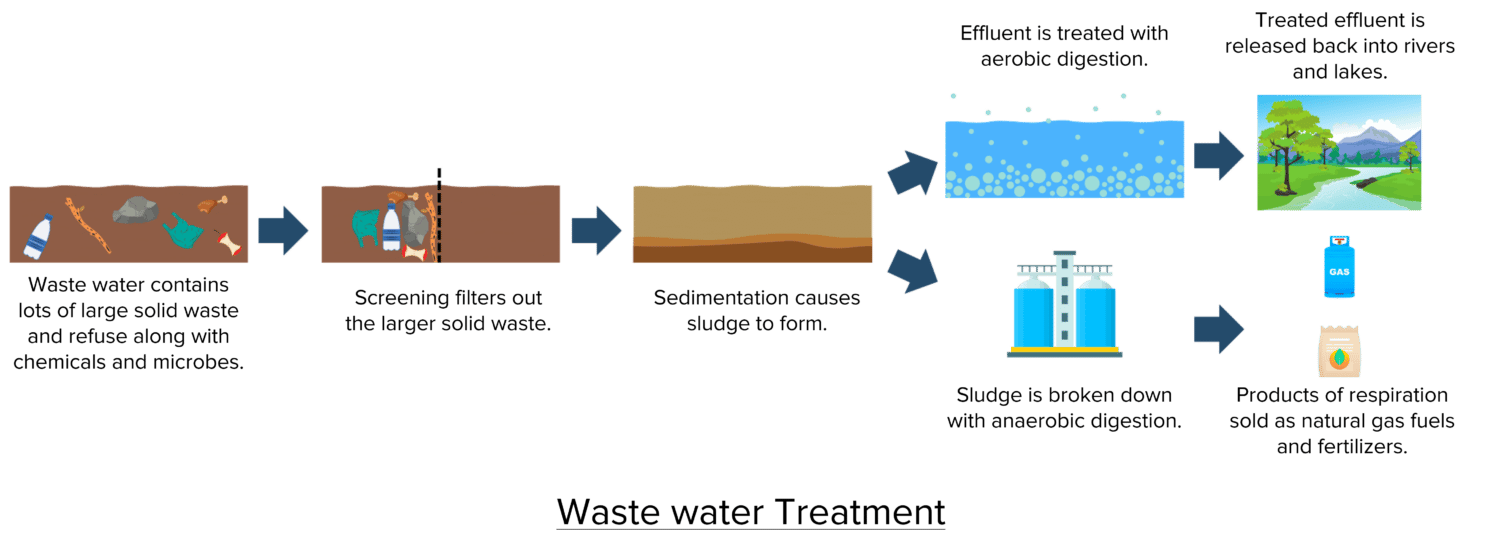Treatment of Waste Water
Treatment of Waste Water Revision
Treatment of Waste Water
Waste water is produced in urban environments in peoples homes and industries, and on farms. This water contains a range of contaminants that are harmful and as such it requires more complex treatment than fresh water or sea water to make it potable. Waste water is also unsafe for release into the environment.
Sources of Waste Water
Waste water is generated primarily in two ways. The first is the generation of sewage and waste water in towns and cities. Water is used in peoples homes for a range of purposes such as showering, washing clothes and kitchen ware, and using the toilet. Once used, this water will be contaminated with microbes and waste and flows into sewers as waste water. Waste water is also generated in urban industry as coolants and lubricants.
The second way in which in waste water is generated is through agriculture. Water that runs off fertilised fields often contains chemical and nutrient pollutants (e.g. nitrogen and phosphorous). A lot of waste water is also generated as slurry from cattle (effectively a mixture of bodily waste produced by farm animals).
Both sources will produce water that often contains a range of contaminants including bacteria, organic matter, human and animal waste, and harmful chemicals. These contaminants are harmful to both people and to the environment and so waste water can’t be released safely into sources of freshwater such as lakes or rivers. Instead it must first be treated.
How is Waste Water Treated
The treatment of waste water is more complex than the production of potable water from already clean sources. This is because waste water is often much more polluted than fresh water or sea water. The pollutants present in waste water are also quite harmful.
There are three steps in the treatment of waste water: Screening, sedimentation and aerobic or anaerobic digestion.

Screening
The waste water that is generated in cities and on farms will often contain a large number of solid objects. These may be natural debris such as twigs and rocks, or man made refuse such as plastic bags, bottles, and food waste. Before waste water can be treated these solid contaminants must be removed. This is done by passing the water though a series of filters that will catch large solid objects.
Sedimentation
Once screened, the waste water is pumped into large tanks and allowed to stand. This is done to allow the separation of the remaining solid contaminants from the liquid ones. Over time, the heavy solids that are suspend in the waste water will sink to the bottom of the tank, forming a thick and heavy sludge. The lighter contaminants that remain at the top of the tank are known as effluent. The sludge and effluent will then be separated from one another to undergo different treatments.
Aerobic Digestion
Once the effluent is isolated, it is treated using aerobic digestion (digestion with oxygen). In this process, oxygen is pumped through the effluent encouraging bacteria in the effluent to break down any organic matter or other microbes suspended in the liquid. This will remove the remaining contaminants, leaving clean water. This water is then safe to release into natural water sources such as lakes and rivers.
Anaerobic Respiration
The remaining sludge is taken away and transferred in to sealed tanks. These tanks contain no air or oxygen, encouraging different bacteria to break it down using anaerobic digestion (digestion without oxygen). The break down of the sludge generates a range of products such as methane gas and fertilizers which can be used in other industries.
Waste water containing toxic contaminants like heavy metals or dangerous bacteria will undergo additional treatment steps. Some of these include sterilisation with ultraviolet light or the addition of chemicals that will cause further sedimentation.
Treatment of Waste Water Example Questions
Question 1: State why the production of potable water from waste water is more difficult than from fresh water.
[4 marks]
Waste water contains more contaminants, many of which are harmful, that must be removed before it is safe to drink.
Fresh water often contains fewer harmful contaminants and so is easier to treat.
Question 2: Define the term ‘anaerobic digestion’.
[2 marks]
Digestion by bacteria in the absence of oxygen.
Question 3: Describe the process of sedimentation in the treatment of waste water.
[5 marks]
- Waste water than has been screened is pumped into a large tank and allowed to stand.
- Over time the heavier solid contaminates sink to the bottom of the tank.
- This forms a sludge on the bottom of the tank, leaving the lighter effluent on top.





